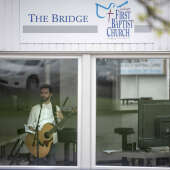The Boatmen's Way: Where many area bankers got their start

In the '80s and '90s, Boatmen's Bank was the team everyone wanted to be part of -- from bankers to board members to customers. It dominated the market, and many of the 30-something-year-old bankers at that time spent their formative years leading the "Boatmen's Way," a philosophy that guided their future careers.
In 1982, Farmers and Merchants Bank of Cape Girardeau was sold to Boatmen's Bank, with its headquarters in St. Louis. Boatmen's Bank would operate in Cape Girardeau until 1997 when NationsBank merged with Boatmen's and was the surviving entity. (NationsBank purchased Bank of America, though Bank of America was the surviving name.) But for a window of time at the end of the 20th Century, Boatmen's was a market leader in Cape Girardeau and Jackson.

At the center of Boatmen's success was Jim Limbaugh, now the regional president and executive vice president of Montgomery Bank in Cape Girardeau.
A young man in his 20s, Limbaugh was working at Mercantile Bank when he met Jay Burchfield at a Lions Club meeting. He remembered being "intrigued" by Burchfield, who came from West Plains, Missouri, and was then leading the Boatmen's operation in Cape Girardeau.
Soon after, Limbaugh was approached to take a job with another bank. "And I just didn't have a real good feeling about that," Limbaugh said. He called Burchfield to get input. Instead of taking the job in question, Limbaugh was recruited to join Boatmen's. Four years later, at age 32, Limbaugh was named president of Boatmen's Bank in Cape Girardeau when his mentor, Burchfield, left to become president of Boatmen's Bank in Springfield, Missouri.
Along the way, a "dream team" of bankers would come on board, several who, along with Limbaugh, participated in a roundtable discussion recently with B Magazine. Along with Limbaugh, these four individuals shared their insight on the Boatmen's Bank era:
* John M. Thompson, who retired in 2018 from The Bank of Missouri as president in Cape Girardeau, worked on the real estate side of the Boatmen's operation.

* Danny Essner, retired president of Capaha Bank, joined Boatmen's in 1984 after working for Ford Motor Credit in Fort Worth, Texas.
* Kathy Bertrand, who retired after serving as community bank president of First Midwest Bank in Cape Girardeau, joined about the same time as Essner. Bertrand got her start on the operations side and by the early '90s would become the first female commercial lender in Cape Girardeau.

* Jay Knudtson, executive vice president at First Missouri State Bank, joined Boatmen's in 1990 after getting his start in Minneapolis.
During the course of an hour-long conversation, the five bankers talked about the bank's success, how real estate and company culture played important roles and how Boatmen's owned the market with between 42 to 44% market share. Here is what they shared.
Banking and real estate

Entering the real estate business was part of Boatmen's success, John M. Thomson said. Community banks traditionally left that line of business to the savings and loan and mortgage bankers. With many of these operations locked into fixed interest rates, 20% in some cases as a carry over from the Jimmy Carter era, there was an opening in the market.
"Banks and savings and loans were stuck with those fixed-rate mortgages, and yet had to pay depositors, so the math just doesn't work," Jim Limbaugh said. "And so that's when adjustable rates became in vogue and some of those kinds of things happened."
An aggressive mortgage department helped lead the way with the customer relationship.
"The mortgage department knew no equal," Limbaugh said. "It was as sound and, frankly, profitable as any line of business at the bank. It created the retail part of the bank because it created those retail deposits. And they were very inexpensive."

After opening up the first mortgage company in Cape Girardeau -- Fleet Mortgage -- Jay Knudtson started with Boatmen's in 1990 where he joined the real estate team.
"I was working for a mortgage company, and I'll never forget them saying your only competition in Cape Girardeau was going to be Butch Holyfield at Boatmen's Bank," Knudtson said.

Local decisions
Knudtson explained that with Boatmen's, each community bank had its own charter. That provided more autonomy and local decision-making on interest rates and deposit-to-loan rates.
Part of the reason for the dominant position had to do with bank structure and the flexibility to be aggressive with good loan opportunities.
"That's vitally important because like the national banks today, they have one charter," Knudtson said. "So what they're doing in St. Louis, they have to do in Cape Girardeau. So it was that independence we had by having our own charter that allowed us to be strategic for our own communities."
However, the charter was part of the holding company, which allowed the local bank to be aggressive with good loan opportunities.
Limbaugh recalled calling the St. Louis offices to report the loan-to-deposit ratio was at 86%, questioning whether the bank could proceed with future loans. The response he received: "You have good loans to make, we'll get you the money."
"And the community bank system at Boatmen's was a huge profit source, because they were in localized markets with local decision-making responsibility, typically more diverse, and very little risk in their portfolios," Limbaugh said. "In other words, we didn't have many charge offs. And so that's why we just turned it on. And we had the resources to be able to do that. And, quite frankly, the investment portfolio was the mortgage portfolio."

Knudtson added context in that banking today has more restrictions than during the Boatmen's era.
"Whereas right now, banks have to manage legal lending limits. There's only so much they can lend without getting participation," Knudtson said. "Because we were part of that big holding company, from the time I was at Boatmen's Bank, [Jim] Limbaugh had that pedal down the whole time. The only thing you were managing was credit risk."
The healthy diversification of industry in the market also translated to the board of directors, particularly after Boatmen's purchased Centerre Bank. Some of the board members: Charlie Hutson, Jerry Zimmer, Gene Huckstep, Mike Kohlfeld, Mike Bennett, Dennis Marchi, Jerry Lorberg, J. Ronald Fisher, Al Spradling III and Ed Kiefner. Like the managing team, the board was relatively young but representative of the area's business landscape and not dominated by one particular sector.
"They loved being part of a winning team," Thompson said of the board members. "You know, that's why they survived and stayed so long and were able to support all of that enthusiasm that was born out of the team, in my opinion. That's what attracted those board members. 'They're No. 1. I want to be associated with No. 1. Do you want to be on the 13th? No. I want to be on the first team, the Dream Team.' And I think that was another thing that brought them to us."
Kathy Bertrand added that the age of the core team, all in early to mid-30s, was relatively young compared to what is expected in senior-level banking.
"You got a whole lot of people in there to be able to do that at that age, instead of doing that at age 45 or 48, or something like that," she said. "That, I think -- that's amazing. I really do."
Limbaugh added, "In spite of youth, everybody knew that it was very serious business and that we're not going to be cavalier about this. We're going to treat each other well. And we're going to be respectful of each other and our customers. But it's serious business, and we have a responsibility to provide whatever was our responsibility to Boatmen's."

Once you were part of the Boatmen's culture, you likely were not quick to leave. Knudtson said at one point, he left the company for about two months to pursue another opportunity. But soon after, he realized it was a mistake.
"The aching in my gut wasn't so much about how dissatisfied I was with my new job but rather how terribly I missed being part of the Boatmen's Team," Knudston wrote to me in a follow-up email. "To Jim Limbaugh's credit, he immediately hired me back, and I will be forever grateful for that! I was a living, breathing testimony that the 'grass wasn't greener' elsewhere."
Limbaugh pointed to two simple, yet important, concepts that shaped how business was done at Boatmen's Bank: The Golden Rule and community.
"How basic is it? Treat other people the way you yourself want to be treated," Limbaugh said. "It's just so hard for people to execute. The other is, there was an absolute expectation to be involved in some capacity in the community. I didn't care if it was singing in the church choir or being the Boy Scout master or being on the city council. It didn't matter, but you had to do it because people saw that, and people see that it's human nature to be attracted to people that have some semblance of success because people are intrigued by it."


































Respond to this story
Posting a comment requires a subscription.